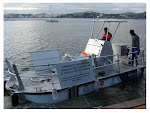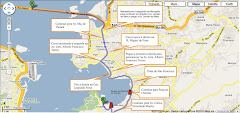What Is an Urban Heat Island?
As urban areas develop, changes occur in their landscape. Buildings, roads, and other infrastructure replace open land and vegetation. Surfaces that were once permeable and moist become impermeable and dry.1 These changes cause urban regions to become warmer than their rural surroundings, forming an "island" of higher temperatures in the landscape.
Heat islands occur on the surface and in the atmosphere. On a hot, sunny summer day, the sun can heat dry, exposed urban surfaces, such as roofs and pavement, to temperatures 50–90°F (27–50°C) hotter than the air,2 while shaded or moist surfaces—often in more rural surroundings—remain close to air temperatures. Surface urban heat islands are typically present day and night, but tend to be strongest during the day when the sun is shining.
In contrast, atmospheric urban heat islands are often weak during the late morning and throughout the day and become more pronounced after sunset due to the slow release of heat from urban infrastructure. The annual mean air temperature of a city with 1 million people or more can be 1.8–5.4°F (1–3°C) warmer than its surroundings.3 On a clear, calm night, however, the temperature difference can be as much as 22°F (12°C).3
To view images of surface and atmospheric heat islands, and to learn more about how scientists measure them, visit the Measuring Heat Islands page.
The heat island sketch pictured here shows how urban temperatures are typically lower at the urban-rural border than in dense downtown areas. The graphic also show how parks, open land, and bodies of water can create cooler areas within a city.
For additional information on urban heat islands:
- read the Heat Island Basics chapter (PDF) (22 pp, 1.5MB) from EPA's Reducing Urban Heat Islands: Compendium of Strategies, which explains the different types of urban heat islands and their causes, describes the impacts of heat islands, and provides resources for more information;
- learn how heat islands are measured; and
- watch two short video segments that EPA developed in partnership with The Weather Channel cable television network.
Why Do We Care About Heat Islands?
Elevated temperature from urban heat islands, particularly during the summer, can affect a community's environment and quality of life. While some heat island impacts seem positive, such as lengthening the plant-growing season, most impacts are negative and include:- Increased energy consumption: Higher temperatures in summer increase energy demand for cooling and add pressure to the electricity grid during peak periods of demand. One study estimates that the heat island effect is responsible for 5–10% of peak electricity demand for cooling buildings in cities.3
- Elevated emissions of air pollutants and greenhouse gases: Increasing energy demand generally results in greater emissions of air pollutants and greenhouse gas emissions from power plants. Higher air temperatures also promote the formation of ground-level ozone.
- Compromised human health and comfort: Warmer days and nights, along with higher air pollution levels, can contribute to general discomfort, respiratory difficulties, heat cramps and exhaustion, non-fatal heat stroke, and heat-related mortality.
- Impaired water quality: Hot pavement and rooftop surfaces transfer their excess heat to stormwater, which then drains into storm sewers and raises water temperatures as it is released into streams, rivers, ponds, and lakes. Rapid temperature changes can be stressful to aquatic ecosystems.
What Can Be Done?
Communities can take a number of steps to reduce the heat island effect, using four main strategies:- increasing tree and vegetative cover;
- creating green roofs (also called "rooftop gardens" or "eco-roofs");
- installing cool—mainly reflective—roofs; and
- using cool pavements.
For more information on heat island mitigation strategies and activities:
- visit the Urban Heat Island Mitigation page;
- read the Heat Island Reduction Activities chapter (PDF) (23 pp, 2.7 MB) from EPA's Reducing Urban Heat Islands: Compendium of Strategies;
- use the Community Actions Database to see what communities around the United States are doing to reduce the urban heat island effect; and
- learn about EPA's Clean Energy-Environment State and Local Program.
Footnotes and References
1. This change in landscape may differ in regions such as deserts, where moisture may increase in urban areas if development introduces grass lawns and other irrigated vegetation.2. Berdahl P. and S. Bretz. 1997. Preliminary survey of the solar reflectance of cool roofing materials. Energy and Buildings 25:149-158.
3. Akbari, H. 2005. Energy Saving Potentials and Air Quality Benefits of Urban Heat Island Mitigation (PDF) (19 pp, 251K). Lawrence Berkeley National Laboratory.
---------------------------------------
Fonte: EPA Basic Information
---------------------------------------
Mais informação sobre o tema no Blog do Axel Grael:
- Telhado verde
- O efeito das ilhas de calor urbano
- Contra ilhas de calor, Stuttgart tem 60% de áreas verdes
- Ilhas de calor urbano causam aumento de temporais em São Paulo
- Calor, frescor e os ventos























Nenhum comentário:
Postar um comentário
Contribua. Deixe aqui a sua crítica, comentário ou complementação ao conteúdo da mensagem postada no Blog do Axel Grael. Obrigado.